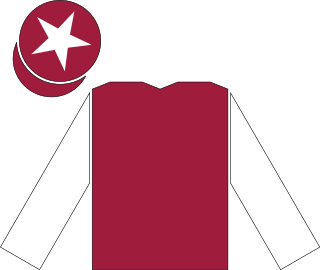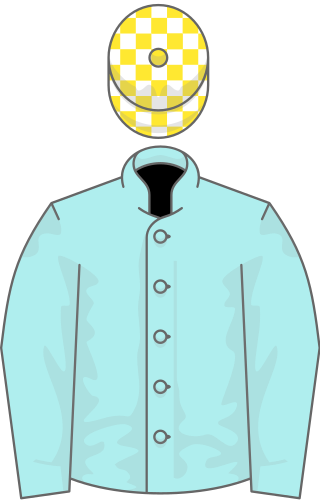Related Research Articles

Whisk Broom II (1907–1928) was an American-bred Thoroughbred racehorse who raced in the United Kingdom and in the United States. Whisk Broom showed high class form during four seasons of racing in Europe, but produced his best performances when returning to America in 1913. He claimed the New York Handicap Triple by winning the Metropolitan Handicap, the Brooklyn Handicap, and the Suburban Handicap, a feat unmatched until Tom Fool achieved it forty years later. Kelso in 1961 and Fit To Fight in 1984 later joined them as the only other horses to win the Handicap Triple. Whisk Broom II's career was ended by injury after his triple success, but he went on to become a successful breeding stallion.
Never Say Die (1951–1975) was an American-bred, British-trained Thoroughbred racehorse. After winning only once from his first nine races, he demonstrated much improved form in the summer of 1954 to win the Derby, becoming the first American-bred colt to win the race in 73 years. Later that year he added a second British Classic, when winning the St. Leger Stakes by a record margin of twelve lengths. He was later retired to a successful stud career.

Red Rocks was an Irish-bred, British-trained Thoroughbred racehorse.
Sovereign Dancer was an American Thoroughbred racehorse best known as a sire of two American Classic Race winners.

Snow Knight was a Thoroughbred racehorse who won Britain's most prestigious race in 1974, the Derby, then the following year earned an Eclipse Award as the American Champion Male Turf Horse.
Caerleon was an American-bred, Irish-trained Thoroughbred racehorse who won Group One races in France and Great Britain. He was twice champion sire in Great Britain and Ireland. Bred by Seth Hancock at his famous Claiborne Farm in Kentucky, he was a son of the 1970 British Triple Crown winner Nijinsky. His dam was Foreseer, a daughter of U.S. Racing Hall of Fame inductee, Round Table.

Ambiorix (1946–1975) was a French Champion Two-Year-Old Thoroughbred racehorse who became a leading sire.
Try My Best (1975–1993) was an American-bred, Irish-trained Thoroughbred racehorse and sire. A son of Northern Dancer, he won the Dewhurst Stakes in 1978 and was the top-rated two-year-old in Britain and Ireland that year.

Shantou was a classic-winning Thoroughbred racehorse and sire. As a three-year old in 1996 he won the St. Leger and the Gran Premio del Jockey Club as well as finishing third in the Epsom Derby and fourth in the Breeders' Cup Turf. In the following year he won the Gran Premio di Milano and the Princess of Wales's Stakes. After his retirement from racing he had success as a sire of National Hunt horses.
Miswaki was an American-bred Thoroughbred racehorse that was a Group One winner in France and a stakes race winner in the United States. He was an important sire of 97 stakes race winners and was the Leading broodmare sire in Great Britain and Ireland in 1999 and 2001.
Habitat was an American-bred, British-trained Thoroughbred racehorse and sire. In a racing career which lasted from April until October 1969, the colt ran eight times and won five races. Unraced as a two-year-old, he proved to be the best European miler of 1969, winning the Lockinge Stakes and the Wills Mile in England and travelling to France to win the Prix Quincey and the Prix du Moulin. He was then retired to stud where he became an outstandingly successful sire of racehorses and broodmares.
Thatch (1970–1983) was an American-bred, Irish-trained Thoroughbred racehorse and sire. In a racing career which lasted from spring 1972 until July 1973 he ran nine times and won seven races. As a two-year-old he won three of his four races and was rated one of the best Irish juveniles of the season. In the following year he finished fourth on soft ground in the 2000 Guineas. In the summer he showed the form which led to him being rated the best European horse of his generation, winning the St. James's Palace Stakes, the July Cup and the Sussex Stakes. He was then retired to stud where he had some success as a sire of winners.

Antonio (1816–1828) was a British Thoroughbred racehorse and sire best known for winning a controversial race for the classic St Leger Stakes in 1819. The classic was run twice after claims of an irregular start, but Antonio's victory in the original running was eventually allowed to stand. The rest of his racing career, which lasted from April 1819 until May 1822 was relatively undistinguished although he won five other races. After two minor successes in 1820 he missed the whole of the 1821 before returning as a six-year-old to win two races at Chester. He was then retired to stud where he had limited success as a sire of winners before his death in 1828.
Crow was a French Thoroughbred racehorse and sire. He was one of the best three-year-olds in Europe in 1976 when he won the classic St Leger Stakes and finished second in the Prix de l'Arc de Triomphe. He went on to win the Coronation Cup as a five-year-old in 1978. After his retirement from racing he stood as a breeding stallion in the United States and Australia with limited success.
Petition (1944–1964) was a British Thoroughbred racehorse and sire. He was officially rated the second-best two-year-old in Britain in 1946 when he won the New Stakes, Richmond Stakes, Gimcrack Stakes and Champagne Stakes. He won on his debut in 1947 but sustained an injury when finishing unplaced in the 2000 Guineas and failed to win in two subsequent races that year. In 1948 he returned to his best form to beat a strong field in the Eclipse Stakes. He was retired to stud where he became a successful and influential breeding stallion.
Pay the Butler was an American Thoroughbred racehorse best known for winning the 1988 Japan Cup. Bred in Kentucky, he began his racing career in France and won two of his seventeen starts before moving back to the United States as a four-year-old in the spring of 1988. He won the Red Smith Handicap on his North American debut and in November he defeated a top-class international field in the Japan Cup. He remained in training for two further seasons and ran well in several major contests but recorded only one minor win. He was retired to stud in Japan but died in 1991 after one season as a breeding stallion.
Emmson was an Irish-bred British-trained Thoroughbred racehorse and sire. He was one of the best staying two-year-olds in Britain in 1987 when he won four of his five races including the Washington Singer Stakes and the William Hill Futurity. He failed to win as a three-year-old but did finish third in the Prix du Jockey Club and ran prominently in the Prix de l'Arc de Triomphe. He remained in training for two more seasons, recording his only subsequent win in the 1989 Prix Gontaut-Biron. After his retirement from racing he had some success as a sire of winners in Brazil.

Saddlers' Hall was an Irish-bred, British-trained Thoroughbred racehorse and sire. After finishing fifth in his only race as a juvenile he developed into a high class staying colt in 1991, winning the King Edward VII Stakes and finishing second the St Leger. He reached his peak in the first half of the following season, winning four consecutive Group races: the John Porter Stakes, Ormonde Stakes, Coronation Cup and Princess of Wales's Stakes. He was retired to stud at the end of the year and had some success as a breeding stallion, siring the St Leger winner Silver Patriarch. He died in 2008 at the age of twenty.
Boswell was a British Thoroughbred racehorse and sire. He showed promise when winning his final start as a two-year-old and was considered a contender for the following year's classic races. In 1936 he was slow to find his best form and ran unplaced in both the 2000 Guineas and the Epsom Derby before recording an upset victory in the St Leger at Doncaster Racecourse in September. As a four-year-old he again upset the odds to take the Eclipse Stakes at 20/1 but failed to win again and was retired from racing at the end of the following year. He later stood as a breeding stallion in the United States, where he had some success as a sire of winners.
Cacoethes was an American-bred, British-trained Thoroughbred racehorse and sire. After finishing third on his only start as a two-year-old he improved to become one of the best colts of his generation in Europe in the following year, winning the Lingfield Derby Trial and the King Edward VII Stakes as well as finishing second in the International Stakes and the King George VI and Queen Elizabeth Stakes and third in the Epsom Derby. In 1990 he showed his best form in Autumn when he won the Turf Classic and ran third in the Japan Cup. After his retirement from racing he stood as a breeding stallion in Japan.
References
- ↑ Biggar, Allan, (ed.), The Stallion Review, 1977